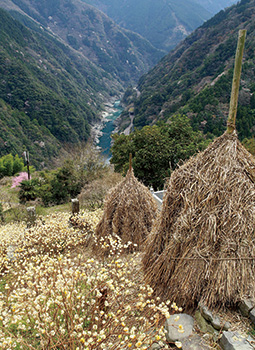INDEX

The sole blacksmith in Nishi-Awa 
Unique farming tools developed and handed down in Nishi-Awa 
Koeguro, bundles of kaya (grass) piled up in a conical shape
- PREVIOUS
- NEXT
September 2021
Nishi-Awa Steep Slope Land Agriculture System

The “steep slope land agriculture system” used in western Tokushima Prefecture for some 400 years has been designated (March 2018) as a Globally Important Agricultural Heritage System (GIAHS) by the Food and Agriculture Organization (FAO) of the United Nations.

In hilly or mountainous areas of Japan, slopes are often excavated to create flat areas for the cultivation of crops. Terraced rice paddies are one example. However, there is a place where for more than 400 years mountain slopes have been farmed just as they are. This is an area of western Tokushima known as the Nishi-Awa region where farming takes place on plots with elevations of between 100 and 900 meters in four locations: Mima City, Miyoshi City, Tsurugi Town and Higashi-miyoshi Town. (“Nishi” means “west” and Awa is the old name for present-day Tokushima Prefecture.) In some places, slopes are as steep as 40 degrees, and to farm on such an incline unique knowledge and techniques have been developed.
One of those techniques involves the use of kaya (grass) collected from nearby grasslands.

If nothing is done, the soil of sloped areas will naturally be washed down little by little by rain, wind and other natural forces. In the Nishi-Awa region, they use kaya as a measure against this. A field to grow the kaya is located somewhere and the grass is harvested in the fall. The harvested kaya is then piled up in a conical shape, left to dry well, and then chopped up finely. By distributing this dried grass in the fields, the soil is fertilized and surface slippage can be prevented. This also controls the growth of weeds and keeps the soil from drying out, and is essential to farming on slopes. The kaya piled up in conical shapes seen from autumn into early winter is called koeguro locally and is a symbol of Nishi-Awa agriculture.

The people here have also been creative with their farming tools. As agricultural tools for flat land are difficult to use on sloped areas without alteration, unique agricultural tools were developed here, such as tools angled to match the steepness of the land used for cultivation. Unique techniques meant to improve the soil environment have been passed down here for generations. These include returning soil that has moved down the slope back up using a tool known as a sarae, and creating soil by smashing up the many pebbles in the fields.

The only blacksmith in Nishi-Awa who can make and repair these unique tools does so in response to requests.
Fujimoto Masaya, who works at the Tsurugi Town Hall in one part of the Nishi-Awa region, says, “In order to preserve these blacksmith techniques, we have started to seek support from local ironworks to have companies, not individuals, learn and pass on these techniques to the next generation.”
Presently, as well as growing grains such as millet, many farmers in the Nishi-Awa region grow small amounts of a variety of agricultural products, including the traditional vegetables of buckwheat, potatoes, and Goushuimo potatoes. However, this doesn’t tend to bring in much income.
“If this farming does not continue to happen, this system of agriculture and these landscapes will be lost," Fujimoto says. “We are working to increase the added value of these agricultural products, such as the introduction in recent years of a brand certification system for agricultural products produced through this system in collaboration with the prefecture, city and town.”
The landscape of the Nishi-Awa region, with approximately 200 villages still clinging to the steep mountain slopes, is said to be just as it was long ago. Protecting this globally-rare and unique agricultural system will also lead to the protection of this unique landscape.
- PREVIOUS
- NEXT

